
|
Unit 4 Machines |
School: : Zarechnaya school-lyceum Kostanay district, Kostanay region Kostanay district, Kostanay region |
||||||
|
Date: 26.07.19г. |
Teacher name: Koishibayeva Zamzagul Iglekovna |
||||||
|
CLASS: 4. |
Number present: |
absent: |
|||||
|
Lesson title |
Robots 1 |
||||||
|
Learning objectives(s) that this lesson is contributing to (link to the Subject programme) |
4. R6 understand with some support some specific information and detail in short, simple texts on a growing range of general and some curricular topics 4. W5 link with some support sentences using basic coordinating connectors (prepositions of location: behind, between, in front of, next to, near)
|
||||||
|
Lesson objectives |
All learners will be able to: read the text and highlight simple specific sentences about Robots write 3-4 sentences about robots using the simple specific sentences with teacher’s support Most learners will be able to: read text about robots and identify the simple specific sentences with little teacher’s support. write 4-5 sentences about robots using the specific sentences with little teacher’s support. Some learners will be able to: read text about robots and identify the specific sentences without teacher’s support. write 5-6 sentences about robots using the specific sentences without teacher’s support. |
||||||
|
Assessment criteria |
read specific information about robots understand specific information about robots describe in written form about robots identify specific information about robots give answers to the questions using 3-6 sentences on the topic “Robots”. |
||||||
|
Language objective |
Learners can: Read and identify the specific information of the text Write 3-6 sentences about the robots. Subject – specific vocabulary: Robots’ names (Nao, Kiboro, Asimo), behind, between, in front of, next to, opposite Useful sets or specific sentences : Robots can… Robotos can’t… Robots has got … Robots hasn’t got… Robots is … Robots isn’t… Robots are… Robots aren’t… |
||||||
|
Values links |
creative and critical thinking, communicative ability |
||||||
|
Cross-curricular links |
Science |
||||||
|
Previous learning |
Fast machines 2 |
||||||
|
Plan |
|||||||
|
Planned timings |
Planned activities (replace the notes below with your planned activities) |
Resources |
|||||
|
Start 1- 3min 4-5min
6-7min |
Greeting. Duty questions. 1. Creation of collaborative atmosphere Method “I wish”. The teacher and learners greet each other. Learners turn and wish good luck to each other with the help of their fingers. I wish you good luck anytime and anywhere.
Learners match pictures with words and guess the theme of the lesson. Answer the question Guessing the learning objectives by the pictures.
|
PPT slide 1
PPT slide3
PPT slide5
|
|||||
|
Middle 8-9
10-12 min
13-15 min
16-20 min
21-27min
28-29min
30-35min |
2. Division into 3 groups. “Pictures” method. Division is conducted with the help of pictures devoted to the lesson topic
1. “ASIMO”
2 “.NAO”
3. “KIROBO” During the lesson each group will get points: FA 8-7 points -Excellent job! 6-5 points- Good job! 4-1 points- Work harder! Introduction of new words Drilling of new words in [W,G,I], by chain, using the pictures Nao, Asimo, Kiboro, behind, between, in front of, next to, near ACTIVITY 1 Work in groups. Vocabulary work Task 1 Filling in the gap Assessment criteria: 1. Match pictures with their written form correctly using prepositions of location: behind, between, in front of, next to, near, robot’s name 8-7 points -Excellent job! 6-5 points- Good job! 4-1 points- Work batter! Descriptors: A learner 1. knows prepositions of location 2. fills in the gaps correctly 3. chooses prepositions of location correctly Peer assessment Task 2 Choose and make up sentences. Choose and make up 3 sentences using prepositions from the box. Descriptors: a learner · Understands preposition of location · Makes up 3 sentences correctly Teacher assessment
Physical exercise Learners watch the video and repeat the actions.
ACTIVITY 2 Pre-reading activity Task 1 Guessing the content of the text. “Predictions”. Teacher presents the name of the text “Robot”. Looking at the name of the text, learners guess what the text is about. Task 2 Put the following sentences in the correct column Assessment criteria: Divide specific sentences into 2 columns – 7 points 7-6 points- Well-done! 5-4 points-Good job! 3-1 points- Try again! Descriptor: A learner 1. Understands specific sentences by the theme “Robots” 2. Selects 7 sentences into 2 columns correctly. Peer assessment While reading activity. Find the underlined sentences. Robots Robots can have different shapes and sizes. Robots have got two and more arms and legs. Some robots have got long arms and legs. They can be tall, short, thin and fat. They can be simple and complicated. Robots can walk and run. Some robots can play football and dance. Many robots are made to look like people. For example, there is a robot. His name Asimo. He can help people and speak with three people simultaneously. Well, robots cannot see, hear, smell, or think themselves. They cannot laugh or fell pain because they have no feelings. Robots are just machines with computers for brains. Robots make our lives easier. They are good at doing dirty and difficult jobs, and can work for long hours some robots can work in very dangerous places –at the bottom of the sea and in outer space. Perhaps one day every home will have its own robot to tidy bedroom, wash-up or do anything it is told to do! New words: simultaneously Formative assessment: the method “Applause” Post –reading Task 3 Differentiated tasks. For low motivated Text comprehension task. Method of “True/False sentences” Learners read the sentences and correct false sentences. Task. Define true or false sentences. Correct false sentences: Descriptors: a learner 1. Reads the specific sentences 2. Defines true or false sentences 3. Corrects false sentences
For motivated Analysis of the text. Method of “Discussion”. Learners discuss answers to the questions in groups Descriptors: a learner 1. Discusses the questions in groups 2. Expresses his/her opinion about the text 3. Answers the questions according to the text
For high motivated Task 4. Compare the robots with the people using the next phrases in groups.(Diagram Venn) 1.Robots can… 2. Robots cannot … 3. Robots have got … 4. They are… 5 Asimo can … Assessment criteria 1. Compare and write down 8 specific sentences in the diagram Venn -8 points 9-8 points-Excellent job! 7-6 points-Good job! 5-1 points- Work harder! Descriptor A learner 1. knows 8 specific sentences on the topic “Robots” 2. writes 8 sentences by the theme “Robots” 3. compares the subjects and the people Peer assessment |
PPT slide 6
PPT slide 7
handout 1
PPT
handout 2
https://www.youtube.com/watch?v=U9s_bJyEb4k https://youtu.be/L0bsLNeQy18
handout 3
handout 4
PPT slide 9
handout 5
handout 6
handout 7
|
|||||
|
36-38min
39-40 |
Home task: For low motivated Task 1 Write sentences using “hasn’t got”, draw the perfect robot and describe it. Assessment criteria Use “hasn’t got” to describe robots - 8 points Draw the perfect robot and describe with 4 sentences-4 points Descriptors: A Learner 1. Uses the pictures as support correctly 2. Draw a robot correctly 3. Describes your robot with 4 sentences For motivated Task 2 Complete the 5 sentences correctly. For motivated Assessment criteria 1. Knows
For high motivated Task 3 Construct a robot and name it. Compose the small story about your robot. Assessment criteria: Use LEGO or other materials - 4points Use 6 sentences to write the story - 6 points Descriptors: A Learner 1. Constructs a robot creatively. 1. Name it unusually 2. Composes a small story using 6 specific sentences Reflection. Self-assessment “Happy robot” - it was interesting and clear “Charging robot” - the lesson was a little difficult, not everything is clear “Broken robot” - I did not succeed in the lesson
|
handout 8
Handout 9
Handout 10
PPT Slide 10 |
|||||
|
Additional information |
|||||||
|
Differentiation – how do you plan to give more support? How do you plan to challenge the more able learners? |
Assessment – how are you planning to check learners’ learning? |
Health and
safety check |
|||||
|
Differentiation by support - Support by instructions - High motivated helps low motivated - Praise the students Differentiation by resources - Support by videos Differentiation by assessment -assessment criteria -task according to individual abilities of students Differentiation by outcomes -lesson objectives
|
Assessment : Group assessment Peer assessment Self-assessment Teacher’s assessment |
Health saving technologies. Using -physical and active exercises. -ICT technology
|
|||||
|
Reflection
Were the lesson objectives/learning objectives realistic? Did all the learners achieve the lesson objectives/ learning objectives? If not, why? Did my planned differentiation work well? Did I stick to timings? What changes did I make from my plan and why?
|
Use the space below to reflect on your lesson. Answer the most relevant questions from the box on the left about your lesson. |
||||||
|
|
|||||||
|
Summary evaluation
What two things went really well (consider both teaching and learning)?
1:
2:
What two things would have improved the lesson (consider both teaching and learning)?
1:
2:
What have I learned from this lesson about the class or individuals that will inform my next lesson?
|
|||||||
Handout 1
Matching Nao, Asimo, Kiboro, in front of, between, behind, next to, near


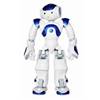


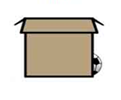
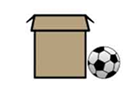
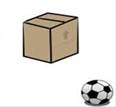
PPT slide 8
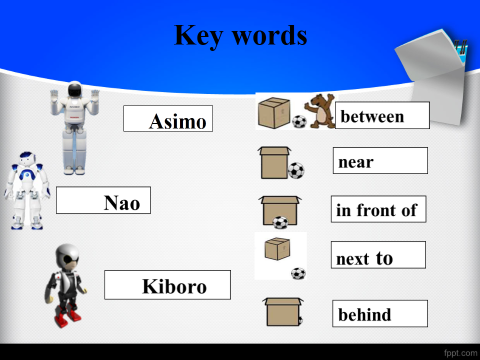
Handout 2
Choose and make up 3 sentences using prepositions from the table
 |
![]()

![]()
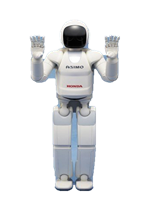
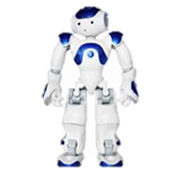
![]()
1. Asimo ____________________________________________
2. Nao ______________________________________________
3. Kiboro_____________________________________________
Key:
1. Asimo is in front of Kiboro
2. Nao is next to Asimo
3. Kiboro is behind Asi
Handout 3
Put the following sentences in the correct column:
Write down from the text 7 sentences with words “can” and “can’t”.
|
A)
|
B)
|
Key words
|
A) can Robots can walk and run. They can help people Some robots can speak with three people Some robots can work Some robots can play football and dance. |
B) can’t Robots cannot see, hear, smell, or think themselves. They cannot laugh or fell pain |
Handout 4
Read the text and find underlined sentences.
Robots
Robots can have different shapes and sizes. Robots have two and more arms and legs. Some robots have long arms and legs. They can be tall, short, thin and fat. They can be simple and complicated. Robots can walk and run. Some robots can play football and dance. Many robots are made to look like people. For example, there is a robot. His name Asimo. He can help people and speak with three people simultaneously. Robots cannot see, hear, smell, or think themselves. They cannot laugh or fell pain because they have no feelings. Robots are just machines with computers for brains. Robots make our lives easier. They are strong and clever. They are good at doing dirty and difficult jobs, and can work for long hours some robots can work in very dangerous places –at the bottom of the sea and in outer space.
Perhaps one day every home will have its own robot to tidy bedroom, wash-up or do anything to tell it to!
Handout 5
For low motivated
Task. Read the text. Define True or False sentences .Correct false sentences
1.
2.
3.
3
4.
5.
Handout 6
For motivated
Task. Answer the questions using information from the text
1) Who is such robot?
2) What can they do?
3) What places can they work in?
4) Why they cannot laugh and fell any pain?
5) Is it good if robots replace people in future?
For high motivated
Task .
“Robots can…” , “Robots cannot…”, “Robots have got…”, “Robots are
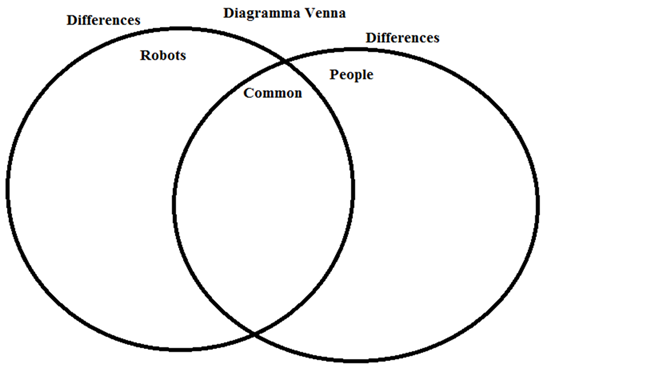
Homework![]() Handout 8 For low motivated
Handout 8 For low motivated
Task 1 What wrong with the robot? Write sentences using hasn’t got. Draw the perfect robot and describe it using four specific sentences.
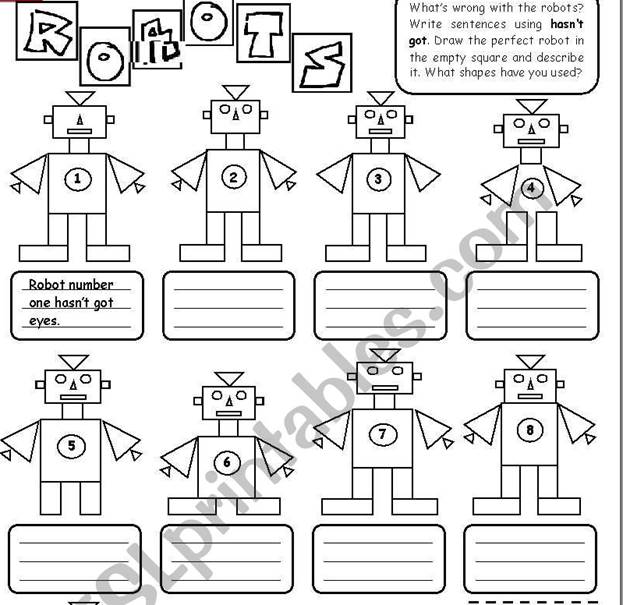
Handout 9 Homework For motivated
Task 2 Match and make up sentences
|
1. Asimo can |
A see, hear, smell, or think themselves. |
|
2. Some robots can |
B two or four arms and legs just machines with computers for brains |
|
3. Robots can’t |
C help people and speak with three people |
|
4. Robots are |
D two or more arms and legs
|
|
5.Robots have got |
E play football and dance |
Key
|
1. Asimo can |
A help people and speak with three people |
|
2. Some robots can |
B play football and dance |
|
3. Robots can’t |
C see, hear, smell, or think themselves. |
|
4. Robots are |
D just machines with computers for brains.
|
|
5.Robots have got |
E two and more arms and legs |
Handout 10 Homework For high motivated
Task 3 Construct a robot using LEGO or other materials and then compose the story about your robot “My robot’s name …”.
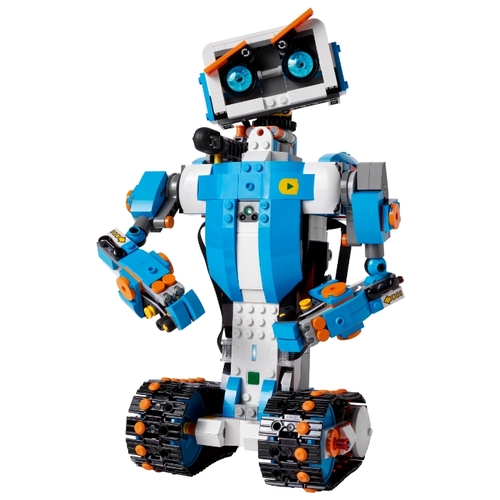
PPT slide 1
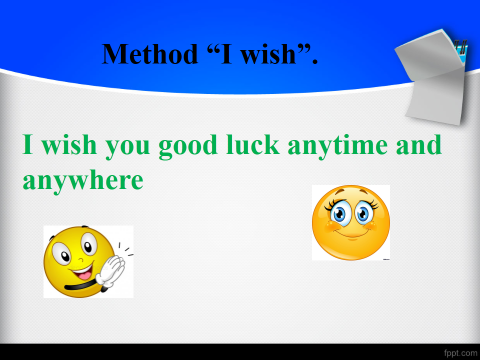
PPT slide 3
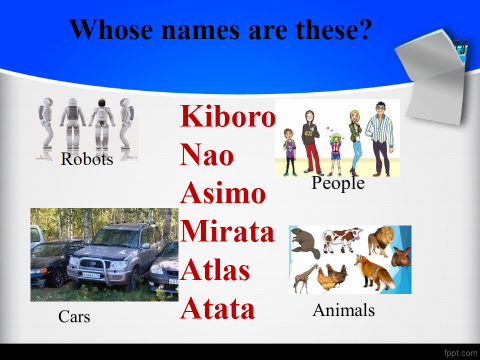
PPT slide 4
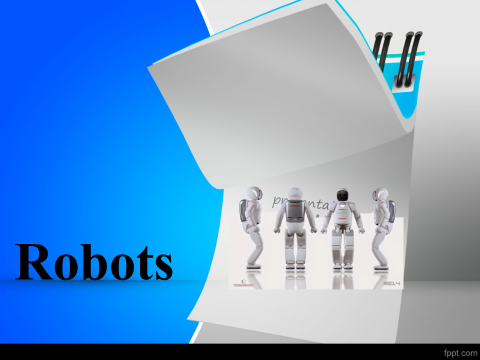
PPT slide 5
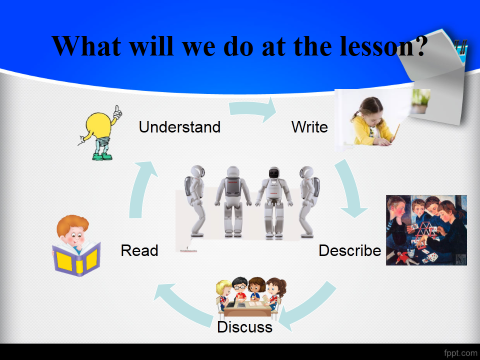
PPT slide 6
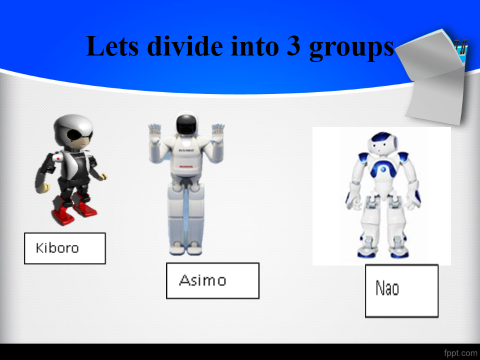
PPT slide 7

PPT slide 9
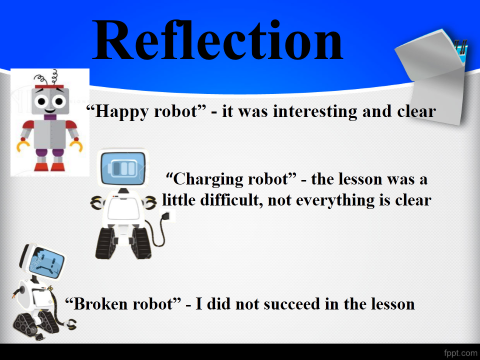
Материалы на данной страницы взяты из открытых источников либо размещены пользователем в соответствии с договором-офертой сайта. Вы можете сообщить о нарушении.